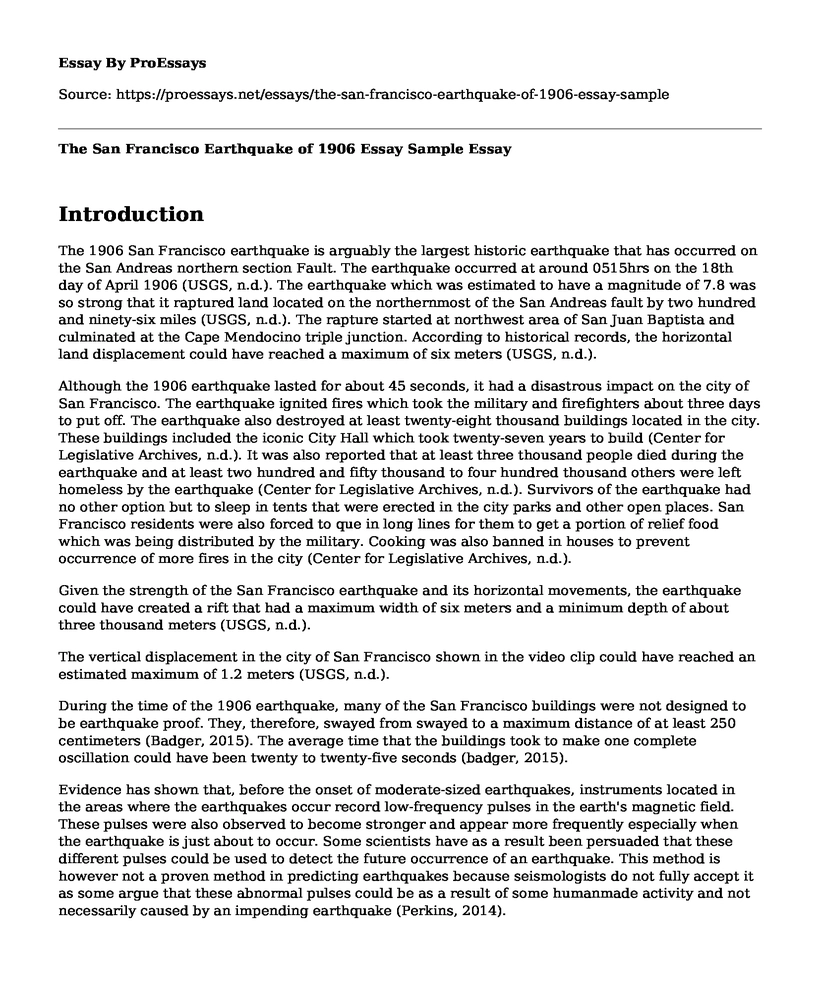Introduction
The 1906 San Francisco earthquake is arguably the largest historic earthquake that has occurred on the San Andreas northern section Fault. The earthquake occurred at around 0515hrs on the 18th day of April 1906 (USGS, n.d.). The earthquake which was estimated to have a magnitude of 7.8 was so strong that it raptured land located on the northernmost of the San Andreas fault by two hundred and ninety-six miles (USGS, n.d.). The rapture started at northwest area of San Juan Baptista and culminated at the Cape Mendocino triple junction. According to historical records, the horizontal land displacement could have reached a maximum of six meters (USGS, n.d.).
Although the 1906 earthquake lasted for about 45 seconds, it had a disastrous impact on the city of San Francisco. The earthquake ignited fires which took the military and firefighters about three days to put off. The earthquake also destroyed at least twenty-eight thousand buildings located in the city. These buildings included the iconic City Hall which took twenty-seven years to build (Center for Legislative Archives, n.d.). It was also reported that at least three thousand people died during the earthquake and at least two hundred and fifty thousand to four hundred thousand others were left homeless by the earthquake (Center for Legislative Archives, n.d.). Survivors of the earthquake had no other option but to sleep in tents that were erected in the city parks and other open places. San Francisco residents were also forced to que in long lines for them to get a portion of relief food which was being distributed by the military. Cooking was also banned in houses to prevent occurrence of more fires in the city (Center for Legislative Archives, n.d.).
Given the strength of the San Francisco earthquake and its horizontal movements, the earthquake could have created a rift that had a maximum width of six meters and a minimum depth of about three thousand meters (USGS, n.d.).
The vertical displacement in the city of San Francisco shown in the video clip could have reached an estimated maximum of 1.2 meters (USGS, n.d.).
During the time of the 1906 earthquake, many of the San Francisco buildings were not designed to be earthquake proof. They, therefore, swayed from swayed to a maximum distance of at least 250 centimeters (Badger, 2015). The average time that the buildings took to make one complete oscillation could have been twenty to twenty-five seconds (badger, 2015).
Evidence has shown that, before the onset of moderate-sized earthquakes, instruments located in the areas where the earthquakes occur record low-frequency pulses in the earth's magnetic field. These pulses were also observed to become stronger and appear more frequently especially when the earthquake is just about to occur. Some scientists have as a result been persuaded that these different pulses could be used to detect the future occurrence of an earthquake. This method is however not a proven method in predicting earthquakes because seismologists do not fully accept it as some argue that these abnormal pulses could be as a result of some humanmade activity and not necessarily caused by an impending earthquake (Perkins, 2014).
According to seismologists, an earthquake with a magnitude of 9.6 cannot occur on the San Andreas Fault. It is because, for such a large magnitude earthquake to occur, the region to be affected should be located in an area which is experiencing an active subduction zone. Fortunately, San Andrea fault has not had an active subduction zone for the long time and therefore cannot be hit by an earthquake with a magnitude of 9.6 (The Hollywood Reporter, 2018).
References
Badger, E. (2015). Retrieved from https://gizmodo.com/how-much-do-skyscrapers-actually-move-1707522178
Center for Legislative Archives. San Francisco Earthquake, 1906. Retrieved from https://www.archives.gov/legislative/features/sf
Perkins, S. (2014). Could Pulses in Earth's Magnetic Field Forecast Earthquakes?. Retrieved from http://www.sciencemag.org/news/2014/06/could-pulses-earths-magnetic-field-forecast-earthquakes
The Hollywood Reporter. (2018). Could San Andreas Happen? Is the Movie Accurate?. Retrieved from http://www.historyvshollywood.com/reelfaces/san-andreas/
USGS. The Great 1906 San Francisco Earthquake. Retrieved from https://earthquake.usgs.gov/earthquakes/events/1906calif/18april/index.php
Cite this page
The San Francisco Earthquake of 1906 Essay Sample. (2022, Aug 03). Retrieved from https://proessays.net/essays/the-san-francisco-earthquake-of-1906-essay-sample
If you are the original author of this essay and no longer wish to have it published on the ProEssays website, please click below to request its removal:
- Ecology Report Example: Waste Water Control in Trinidad and Tobago by the EU Versus that by the USA
- Research Paper on the Climate Change
- Response to Hurricane Katrina vs. Sandy
- Essay Example on Street Refuse: Composition & Sources of Pollution
- Essay on Climate Change Adaptation in US National Parks: Institutional Barriers
- Research Paper on Oil Spills and Their Impact on Freshwater Systems
- Essay on Second Responders in Hurricane Katrina: Examining the Role of the EPA and DOD







